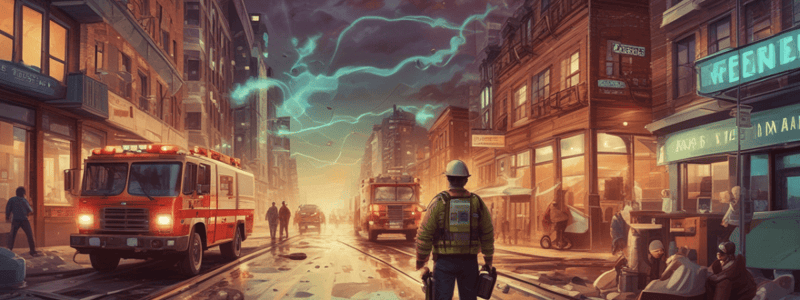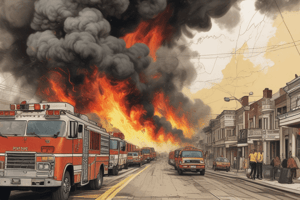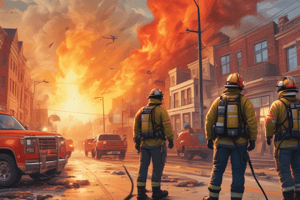Podcast
Questions and Answers
Who is responsible for completing a NFIRS report for an emergency medical incident involving other apparatus responding to the scene?
Who is responsible for completing a NFIRS report for an emergency medical incident involving other apparatus responding to the scene?
- The truck officer
- The Shift Commander
- The ambulance crew
- The still district engine officer (correct)
What should the narrative of the NFIRS report include?
What should the narrative of the NFIRS report include?
- The actions of the Shift Commander
- Only the actions of the unit reporting the incident
- The actions of all companies working at or responding to the emergency incident (correct)
- The actions of the ambulance crew only
Who completes, or directs the completion of, a NFIRS report for all other incidents?
Who completes, or directs the completion of, a NFIRS report for all other incidents?
- The ambulance crew
- The still district engine officer (correct)
- The truck officer
- The Shift Commander
What is the purpose of a supplemental narrative?
What is the purpose of a supplemental narrative?
When is a supplemental narrative required?
When is a supplemental narrative required?
Who is responsible for completing an NFIRS report for a fire incident?
Who is responsible for completing an NFIRS report for a fire incident?
What is the primary purpose of this Administrative Guideline?
What is the primary purpose of this Administrative Guideline?
Who assumes command in the given example?
Who assumes command in the given example?
What is the cause of the fire in the given example?
What is the cause of the fire in the given example?
What is the deadline for submitting reports required by this policy?
What is the deadline for submitting reports required by this policy?
Who can give directions for completing an NFIRS report?
Who can give directions for completing an NFIRS report?
What happens to all other companies in the given example?
What happens to all other companies in the given example?
What information is required in an emergency incident report?
What information is required in an emergency incident report?
What is the title of this Standard Operating Guideline?
What is the title of this Standard Operating Guideline?
Who approved this Standard Operating Guideline?
Who approved this Standard Operating Guideline?
When is this Standard Operating Guideline set to be re-evaluated?
When is this Standard Operating Guideline set to be re-evaluated?
What type of report shall be utilized for a fire narrative?
What type of report shall be utilized for a fire narrative?
Who shall complete an overall narrative of the events at the emergency incident?
Who shall complete an overall narrative of the events at the emergency incident?
What information should be included in the Incident Commander's overall narrative?
What information should be included in the Incident Commander's overall narrative?
What is attached to the Incident Commander's overall report?
What is attached to the Incident Commander's overall report?
Why is the Fire/Narrative Report completed?
Why is the Fire/Narrative Report completed?
Who assumes command in the example scenario?
Who assumes command in the example scenario?
What is the purpose of the supplemental reports from other companies?
What is the purpose of the supplemental reports from other companies?
What is the purpose of submitting the Fire/Narrative Report?
What is the purpose of submitting the Fire/Narrative Report?
What is the primary role of 610 in the given scenario?
What is the primary role of 610 in the given scenario?
At what time was the fire reported 'Under Control'?
At what time was the fire reported 'Under Control'?
What is the estimated total loss from the fire?
What is the estimated total loss from the fire?
When is a NFIRS Hazardous Materials Report required?
When is a NFIRS Hazardous Materials Report required?
Who is responsible for taking pictures of the fire building or area?
Who is responsible for taking pictures of the fire building or area?
What is the purpose of including pictures with a fire incident NFIRS report?
What is the purpose of including pictures with a fire incident NFIRS report?
What triggered the need for an NFIRS Casualty Report in this scenario?
What triggered the need for an NFIRS Casualty Report in this scenario?
Who determined the cause of the fire in this scenario?
Who determined the cause of the fire in this scenario?
What type of fires require pictures to be taken utilizing department photographic equipment?
What type of fires require pictures to be taken utilizing department photographic equipment?
What should a site plan, floor plan or combination drawing include?
What should a site plan, floor plan or combination drawing include?
Who reviews the NFIRS reports completed during their shift?
Who reviews the NFIRS reports completed during their shift?
How are the drawings completed for a structure fire requiring the use of a preconnected or larger hose line(s) stored?
How are the drawings completed for a structure fire requiring the use of a preconnected or larger hose line(s) stored?
Why is a continuous quality improvement (CQI) process important?
Why is a continuous quality improvement (CQI) process important?
What should a brief description of each picture include?
What should a brief description of each picture include?
When are additional pictures taken by the fire investigator?
When are additional pictures taken by the fire investigator?
What notation is required on the drawing(s)?
What notation is required on the drawing(s)?
Flashcards are hidden until you start studying
Study Notes
Administrative Guideline for Emergency Incident Reporting
- Purpose: Standardize reporting of emergency incidents
- Effective Date: January 1, 2022
- Revision: 5
- Approved by: Fire Chief Alan Wax
Policy
- All reports must be completed and submitted to the Shift Commander by the end of the duty day
- Reports should include:
- Units that responded to the incident
- What the first arriving unit(s) found on arrival
- Who was Command at the incident?
- Actions of all companies that participated in the emergency activities at the scene
- Notifications made as a result of the incident
- Final disposition of the incident
- Cause and origin of the fire incident (if known)
Procedure
- NFIRS report shall be completed immediately following each emergency incident
- Duty to complete an incident NFIRS report:
- Fire incidents: first arriving engine officer or directed by the Shift Commander
- Emergency medical calls: ambulance crew when responding alone or still district engine officer when with other apparatus
- Other incidents: company officer of the still district engine
- Narrative of the NFIRS report shall include actions of all companies working at or responding to the emergency incident
Supplemental Reports
- Companies performing services at the scene of structure fires or other incidents shall complete a supplemental narrative describing their actions
- Fire/Narrative Report shall be utilized and completed using the NFIRS Reporting Software
Incident Commander's Overall Report
- Shall complete an overall narrative of the events that transpired at the emergency incident
- Shall include:
- Actions of all companies working at the incident
- Benchmark times
- Location and size of all lines laid
- Location of all apparatus utilized at the incident
- Notifications requested
- Ventilation methods utilized
- Estimated dollar loss of the incident
- Cause and origin of the fire if known
- Tactical worksheet completed for the incident shall be attached to the Incident Commander's overall report
Fire Casualty Report
- NFIRS Casualty Report shall be completed on each individual injury or death associated with a fire emergency incident
- Shall be prompted to complete a Casualty Report whenever an injury or death is noted in the appropriate sections of the main NFIRS report
Hazardous Materials Report
- NFIRS Hazardous Materials Report shall be completed when prompted by the main NFIRS report
- Determined by the information supplied in the "Type of Situation Found" section of the main NFIRS report
Pictures
- Incident Commander shall be responsible to take or assign the taking of pictures of the fire building or area at:
- Structure fires requiring the use of a preconnected or larger hose line(s)
- Structure fires involving death or injury
- Outside fires of unusual nature or involving death or injury
- Vehicle fires involving death or injury
- Pictures shall be taken utilizing department photographic equipment and digitally attached using the Records Management System (RMS)
Drawings
- For all structure fires requiring the use of a preconnected or larger hose line(s), a site plan, floor plan or combination drawing shall be completed
- Drawing(s) shall depict:
- Location of all Fire Department equipment actively involved in the incident
- Location of the command post/vehicle
- Basic building outline
- Basic floor plan of the portion of the structure affected by the fire
- Location of any fire fatalities found inside/outside of the structure
- Location and sizes of all hose lines (attack, relay or supply) laid during the incident
- Street or streets that the structure is located on
- Reference to "north"
- Notation that the drawing is "Not to Scale"
- Drawings will be scanned and attached to the NFIRS report in the RMS
Continuous Quality Improvement
- Report accuracy is of paramount importance and shall be subject to a continuous quality improvement (CQI) process
- Shift Captain shall review the reports that have been completed during their shift
Studying That Suits You
Use AI to generate personalized quizzes and flashcards to suit your learning preferences.



